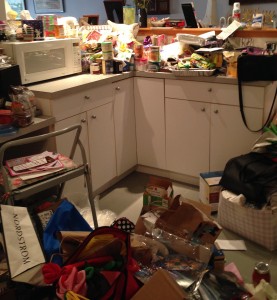Hoarding…Now We Know
 In 2009, I began watching a new series on A&E called, “Hoarders.” There was something familiar to me about the way the professionals worked with their clients and taught well-meaning family members how to communicate with the person who was hoarding. I realized it reminded me of how it felt to be on the front lines with new interventions for our students with autism (and other related disorders) back in the early 1990s!
In 2009, I began watching a new series on A&E called, “Hoarders.” There was something familiar to me about the way the professionals worked with their clients and taught well-meaning family members how to communicate with the person who was hoarding. I realized it reminded me of how it felt to be on the front lines with new interventions for our students with autism (and other related disorders) back in the early 1990s!
When I entered the world of Early Childhood Special Education Teaching, I spent as many hours preparing my classroom environment for individual students as I did on curriculum materials. I bought velcro by the foot, and painstakingly took Polaroid pictures. Of everything!
It was an amazing time to work with young children on the autism spectrum because we were learning so much about how to help our students be available for learning. Instead of being anxious and overwhelmed, we created classroom environments that took into account how our students were processing sensory information and reduced their anxiety from over-stimulation. We celebrated as our students began using photos to communicate, anticipate, and participate.
From the point-of-view of outsiders, cleaning up a hoard seems straightforward enough – sort the stuff, donate what isn’t needed, and discard the trash. But it is never that simple. The person doing the hoarding easily becomes anxious and overwhelmed, often to the point of “shutting down.”
In order to make a difference with my Professional Organizing clients who hoard (yes, I became a Professional Organizer and member of the Institute for Challenging Disorganization because of a tv show!), I have been trained to enter their living spaces without judgement. My immediate goal is NOT to see how many boxes we can fill for donation. It is the same goal I had as an Early Childhood Educator – to create a learning environment that is not anxiety-provoking and to allow the person who hoards the opportunity to communicate, anticipate and participate.
When the real work of “touching stuff” begins, it requires extreme patience. Working with a person who hoards can be mentally and physically draining. Two hours at a time is a good rule of thumb. I do not expect to clear more than a 4’x4′ section if the piles are more than 1′ deep. As bags are emptied or piles are dismantled, we celebrate!
Categorization is taught. Sub-categories are taught. Labels are encouraged. There are set-backs triggered by anxiety and difficulties with communication. But we soldier on. The results are not to society’s generally agreed upon standards of organization, but they provide a safer, more productive environment for the family of the person who hoards.
To be clear, there is still much to learn. Visiting the on-line community, Children of Hoarders, and reading about how it feels to have a parent who hoards is painful. The good news is that awareness is increasing, and there is help for those who seek it.
Now we know, so change is happening! It is an amazing time to work with people who hoard. I am humbled to be a part of it.
Note: To support the site we make money on some products, product categories and services that we talk about on this website through affiliate relationships with the merchants in question. We get a small commission on sales of those products.That in no way affects our opinions of those products and services.

